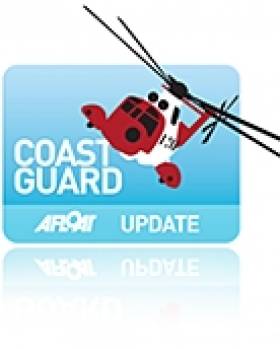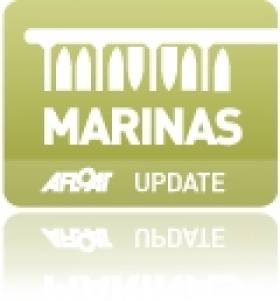Displaying items by tag: Clontarf
The 162 gross tonnes tug had served a career of nearly three decades in Dublin Port, after entering service in 1972. Prior to working in Irish waters the 100ft tug spent the previous decade operating in the UK as Appelsider for Lawson-Batey Tugs Ltd who chartered her to Tyne Tugs Ltd. For historical record and photos click HERE.
In 1998 the Dublin Port Company disposed of the Coliemore alongside her running mate Clontarf (1963/178grt) the former Cluain Tarbh, also built from the same Yorkshire shipyard on the banks of the River Humber.
Initially they were towed to Liverpool but they later appeared at Cork Dockyard in 1999. The Clontarf remained there for a year until she was sold to Barcazas Dominicia SA, Santo Domingo in the Dominican Republic. For photo of the tug in far distant waters click HERE. It was intended Coliemore would follow her Caribbean counterpart but her sale fell-through.
The vessel's ownership eventually transferred to Cork Dockyard where her scrap value will pay for her long-term berthing fees. The tug recently made her final short journey under tow from her berth at the former Verolme Cork Dockyard (VCD) to the facilities slipway where work to break-up the vessel began.
Coliemore and her fleet-mates were given the traditional naming theme of Dublin Bay coastal suburbs spelt in Irish. The naming policy was used by the Dublin Ports & Docks Board (DP&DB) which operated the fleet remained until transferred to the Dublin Port Company established in 1997.
The last tugs to carry the traditional names, Ben Eadar (Howth), Cluain Tarbh (Clontarf) and Deilginis (Dalkey) are now up laid-up awaiting to be sold, to read more click HERE.
Between the 14-16th centuries Dalkey Sound became increasingly important as larger vessels with deeper drafts could no longer enter the port in Dublin due to the dangers of constantly shifting sandbanks and swallow channels in Dublin Bay.
The nearest alternative was for vessels to anchor off Dalkey Island and in the relative shelter of Dalkey Sound where cargoes for the capital where transferred to and fro by lighters to the coastline along Dalkey at Coliemore, which became the principle port for Dublin. Some of the cargo was stored temporally in the medieval castles in Dalkey, otherwise it was directly transported by horse and cart across the plateau to the city.
It was not until the 17th century that the issue of accessing the port of Dublin was resolved, with the completion of the harbour walls that enabled shipping to return on a frequent basis. Captain Bligh of the 'Mutiny on the Bounty' completed mapping Dublin Bay in 1803 which became the most accurate chart at the time and this aided to the safety of mariners.
The fortunes of Dublin's shipping trade increased due to the combination of an easier and safer navigational channel and deeper depths along the quaysides. This led to the eventual demise of shipping using Dalkey. The present-day harbour structure at Coliemore Harbour was constructed in 1868 and is home to a humble fleet of recreational boats and a passenger-ferry service to the island.
- Howth
- Dublin Bay
- Dublin Port
- Clontarf
- Dublin Port Company
- dalkey
- coliemore harbour
- Dalkey Island
- Port of Dublin
- Ports and Shipping News
- Cork Harbour News
- Verolme Cork Dockyard
- VCD
- Dalkey Sound
- Mutiny on the Bounty
- Dublin Port Tugs
- Deilginis
- Captain Bligh
- Dublin port tugs for sale
- Coliemore
- Coliemore tug
- Cork Dockyard
- Cork Dockyard Rushbrooke
- Cluain Tarbh tug
- Ben Eadar tug
- Deilginis tug
- Richard Dunston (Hessle) Yorkshire
- River Humber
- Dublin Ports & Docks Board
- DP & DB
- Cork Dockyard shiprepairers
- Irish shipbuilding
Dublin Port Tug Trio For Sale
The smallest of the tugs for sale is the 17-tonnes bollard pull Ben Eadar (1972/198grt) which was built by Richard Dunston (Hessle) Ltd. She is berthed elsewhere in the port alongside the former Dundalk Port Company owned dredger Hebble Sand, which too has been recently put up for sale. For more information about the grab-hopper dredger click HERE.
Ben Eadar was decommissioned in 2009 and her 35-tonnes bollard-pull fleetmates Cluain Tarbh (1991/268grt) built by McTay Marine of Bromborough and Deilginis (1996/335grt) remained in service until late last year.
Of the trio Deilginis is the last tug commissioned by the Dublin Port & Docks Board (DP&DB) and the 30m tug is also the last to carry a traditional naming theme based on Dublin Bay coastal suburbs spelt in Irish. Deilginis is the Irish for Dalkey, Cluain Tarbh is for Clontarf and Ben Eadar is a translation for Howth.
Deilginis was launched from Astilleros Zamakona S.A. in Bilbao, the same Spanish shipyard that was commissioned by the Dublin Port Company to build two 50-tonnes bollard pull tractor tug sisters. The first newbuild Shackleton entered service late last year and she was followed by Beaufort in early 2010. In March of that year the tugs that cost €6m each to build were officially named in a joint ceremony.
- Dublin Bay
- Clontarf
- Dublin Port Company
- Dundalk Port Company
- howth
- dalkey
- Port of Dublin
- Ports and Shipping News
- Dublin Port Tugs
- Deilginis
- Cluain Tarbh
- Ben Eadar
- Dublin Port & Docks Board
- Hebble Sand
- Dredger for Sale
- VoithSchneider trator tugs
- EastLink bridge
- North Wall Extension
- Dublin Bay suburbs
- McTay Marine
- Richard Dunston (Hessle) Ltd
- Astilleros Zamakoza S.A. Bilbao
Coast Guard Rescues Woman in Clontarf
A Coast Guard helicopter was dispatched to rescue a woman from the water close to Bull Bridge in Clontarf on Sunday night, The Irish Times reports.
Four Coast Guard search teams were deployed to the area after a passer-by notified gardaí of a woman walking in shallow water near the seafront wall around 6pm.
A member of one of the search teams spotted the woman in waist-deep water between the Clontarf seafront and Dublin Port. Coast Guard rescue helicopter 116 then moved in to lift her from the water.
The woman, who was reportedly disoriented and in a confused state, was transferred to ambulance and taken to hospital for treatment.
Marina Manager Course Held in Dublin
As part of the course the group developed a marina scheme for Clontarf Yacht and Boat Club.
By basing the course in Ireland delegates were able to experience at first hand Irish facilities, some for the first time. Sarah Dhandar, Director of Training at the BMF expressed her delight at the venue, "superb facilities, conveniently close by".
E-Boat
Graham Smith wrote in the March 2009 Afloat: "Clontarf and Skerries are the two promoters of the E-Boat and between them have 27 boats which race competitively at both club and open level. That number includes two boats which returned to the fold after restoration following bad damage during a storm two years ago.
Eighteen boats – effectively 70% of the national fleet – contested the National Championships in Clontarf and after six tight races, Pat O’Neill in OctopussE of the host club emerged victorious.
The other open events went to other skippers, with Pat Gilmour winning the Howth Lambay Race and John Denham winning the third Annual Liffey Challenge, an entertaining addition to the class’s racing calendar where the course boundaries are determined by solid quay walls.
The same events will feature in the E-Boat schedule for 2009 with the addition of a separate start at the Dun Laoghaire Regatta.
National Champion: Pat O’Neill, Clontarf Y&BC"
Clontarf Yacht & Boat Club – MaryRose Curran, tel 086 384 1936
Skerries Sailing Club – Ray Wall, email:[email protected]
Background
The E-Boat, designed by Julian Everitt, went into production in 1976 and to date there are in the region of 250 E-Boats around the world. She was designed to comply with IOR rules and is basically a 22 feet, four berth trailer/sailer. For the full story look at The E-Boat Story.
Specifications
Length Over All (LOA) 6.7 m Sail Areas
Length at Water Line (LWL) 5.5 m Mainsail 8.5 m²
Beam 2.8 m No.1 Genoa 15.6 m²
Draught (Keel locked down) 1.4 m No.2 Genoa 12 m²
Draught (Keel fully retracted) 0.25 m No.3 Jib 7.4 m²
Displacement 975 kgs No.4 Storm Jib 2.5 m²
Ballast 318 kgs Spinnaker 32 m²
The E Boat Class Association currently has a membership of around 100 worldwide, but with the majority of members living in and sailing around Great Britain, Ireland, The Netherlands and Denmark.
(Above information courtesy of the International E-Boat Class Association)
International E-Boat Class Association (UK)
There is a space for Irish boating clubs and racing classes to use as their own bulletin board and forum for announcements and discussion. If you want to see a dedicated forum slot for your club or class, click here
Clontarf Yacht and Boat Club

Many of the club members have attained National Champion status in E Boats, Mermaids, Fireballs, GP14s, IDRA14s and Lasers. Clontarf Yacht & Boat Club has hosted a number of International events without any undue pressure on expertise resources. The club has achieved a reputation for its ability to host National and International events.
At present the club provides house facilities to existing and visiting members, a large capacity launch and full time boatman to provide a ferry service to the boats and moorings. The Boatman is also on radio call to members and visitors, (Ch M37 Callsign 'Tarf Launch'). CY&BC has provided visitor-berthing positions for a number of years.
Clontarf Yacht & Boat Club have hosted the following events over recent years:
E Boat Irish National Championships
Fireball Leinster Championships
IDRA14 Open
Mermaid National Championships
International Match Racing
Over the years the club cruising section has built up a good relationship with a number of clubs on the West Coast of England and Wales and cruisers from these clubs visit Clontarf. Also the club fleet visits Northern Ireland on a regular basis and are always well received and entertained by the host club. The club is twinned with Peel Yacht Club in the Isle of Man.
The Junior Section sail in Optimists, Mirrors, 420s and Lasers. During the whole of the Summer Months qualified instructors are employed to provide a structured learning environment for the juniors. Juniors are aged between 10–18 years of age and courses are ISA (Irish Sailing Association) recognized. The junior section of the club has been used as a model upon junior sailing in Ireland is based.
Sail Training
Adults aged 18+ with no experience – This course is well attended by people who wish to gain experience sailing a range of boats from dinghies to large cruisers. The course usually runs in the early Summer Months (May-June)
Adults aged 18+ with experience – Courses are based on internationally recognized ISA (Irish Sailing Association) courses for 'Competent Crew', 'Day Skipper', 'Yachtmaster', 'Coastal Skipper' and 'Offshore Skipper'. The club also provides courses and examinations on VHF radio handling.
Social Members – Non sailing members together with sailing members can enjoy a full range of all year activities such as Table Quizes, Bands, BBQ's, Music Nights, Snooker, Darts, Bridge or a relaxing drink in the refurbished members' bar or lounge.
(The above information and image courtesy of Clontarf Yacht & Boat Club)
Clontarf Yacht & Boat Club, Belvedere, Clontarf, Dublin 3. Tel: 01 833 2691
Have we got your club details? Click here to get involved
































































